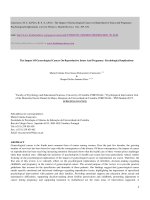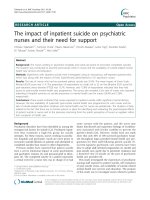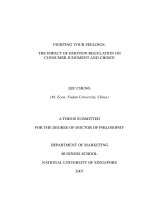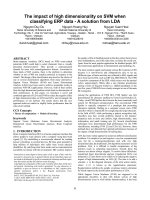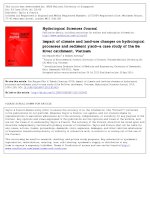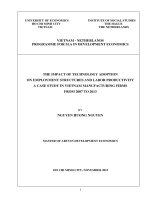The impact of technology adoption on employment structures and labor productivity a case study in vietnam manufacturing firms form 2007 to 2013
Bạn đang xem bản rút gọn của tài liệu. Xem và tải ngay bản đầy đủ của tài liệu tại đây (1.33 MB, 85 trang )
UNIVERSITY OF ECONOMICS
HO CHI MINH CITY
VIETNAM
INSTITUTE OF SOCIAL STUDIES
THE HAGUE
THE NETHERLANDS
VIETNAM - NETHERLANDS
PROGRAMME FOR M.A IN DEVELOPMENT ECONOMICS
THE IMPACT OF TECHNOLOGY ADOPTION
ON EMPLOYMENT STRUCTURES AND LABOR PRODUCTIVITY
A CASE STUDY IN VIETNAM MANUFACTURING FIRMS
FROM 2007 TO 2013
BY
NGUYEN HUONG NGUYEN
MASTER OF ARTS IN DEVELOPMENT ECONOMICS
HO CHI MINH CITY, NOVEMBER 2015
1
UNIVERSITY OF ECONOMICS
HO CHI MINH CITY
VIETNAM
INSTITUTE OF SOCIAL STUDIES
THE HAGUE
THE NETHERLANDS
VIETNAM - NETHERLANDS
PROGRAMME FOR M.A IN DEVELOPMENT ECONOMICS
THE IMPACT OF TECHNOLOGY ADOPTION
ON EMPLOYMENT STRUCTURES AND LABOR PRODUCTIVITY
A CASE STUDY IN VIETNAM MANUFACTURING FIRMS
FROM 2007 TO 2013
A thesis submitted in partial fulfilment of the requirements for the degree of
MASTER OF ARTS IN DEVELOPMENT ECONOMICS
By
NGUYEN HUONG NGUYEN
Academic Supervisor:
PROF.DR. NGUYEN TRONG HOAI
HO CHI MINH CITY, NOVEMBER 2015
2
Declaration
“The thesis entitled “The impact of technology adoption on employment
structures and labor productivity. A case study in Vietnam manufacturing firms
form 2007-2013” is the requirement for the degree of Master of Art in Development
Economics to the Vietnam – The Netherland Programme (VNP).”
Nguyen Huong Nguyen
3
Acknowledgments
I have taken efforts in writing this thesis. However, it would not have been
possible without the kind support of many people. I would like to extend my sincere
thanks to all of them.
I wish to express my deep sense of gratitude and thanks to my supervisor,
Prof.Dr. Nguyen Trong Hoai for his invaluable guidance and constant
encouragement which has sustained my efforts at all the stages of this thesis work.
Sincere thanks also go to Dr. Pham Khanh Nam for his valuable comments and
suggestions for my concept note as well as for his enthusiasm of helping me
collecting data. It is also my duty to record my gratefulness to all VNP lecturers
who have helped and taught me a great deal of useful knowledge.
My appreciations go to my classmates who have willingly helped me out
with their abilities and accompanied with me at VNP during two years. I am also
very much thankful to VNP officers and librarian for all their assistances of
available lab room, library and study materials.
Finally, I owe a debt of gratitude to my parents for inspiring me and keeping
me going to this work.
Nguyen Huong Nguyen
4
Abbreviations
ASEAN
: Association of Southeast Asian Nations
NBER
: The National Bureau of Economic Research
OECD
: Organization for Economic Co-operation and Development
U.S
: The United States
R&D
: Research and Development
DANIDA
: Danish International Development Agency
FDI
: Foreign Direct Investment
SOEs
: State-Owned Enterprises
GSO
: General Statistics Office
CIEM
: Central Institute for Economics Management
GDP
: Gross Domestic Product
APO
: Asian Productivity Organization
HIDS
: Human Identification Solutions Conference
VRA
: Vietnam Rubber Association
MIT
: Ministry of Industry and Trade
5
Abstract
This study investigates directly the impact of technology adoption on
employment structures and labor productivity in Vietnamese manufacturing firms
by using the panel data from the Survey of Small and Medium Scale Manufacturing
Enterprises (SMEs) from 2007 to 2013. Results show that adopting technologies
into production positively affects the share of professionals including engineers,
technicians,
accountant/economist
and
other
professionals
in
Vietnamese
manufacturing firms. However, applying manually operated machineries and
operated computers could lead to the decrease in added value per worker while
other factory equipments seem not to have any effect. The study also finds that the
capital-intensive firms hire more nonproduction workers and gain higher labor
productivity.
Keywords: Technology adoption; employment structures; labor productivity;
operated personal computer; factory equipment; manufacturing firms.
6
Table of contents
Chapter 1: Introduction .............................................................................................11
1.1.
Problem Statement ..........................................................................................11
1.2.
Research objectives: ........................................................................................13
1.3.
Research questions ..........................................................................................13
1.4.
The scope of the study ....................................................................................13
1.5.
The structure of the study ...............................................................................13
Chapter 2: Literature review .....................................................................................15
2.1. Key concepts: .....................................................................................................15
2.1.1. Technology and technology adoption .............................................................15
2.1.2. Employment structures ...................................................................................16
2.1.3. Labor productivity...........................................................................................16
2.2. The relationship between technology adoption and employment structures .....17
2.3. The relationship between technology adoption and labor productivity .............19
2.4. The relationship between firm characteristics and employment structures .......21
2.5. The relationship between firm characteristics and labor productivity ...............22
2.6. The relationship between capital-labor ratio and labor productivity as well as
the correlation of capital-labor ratio and employment structures .............................22
2.7. Conceptual framework: ......................................................................................23
Chapter 3: Data and Research methodology .............................................................24
3.1. Model specification ............................................................................................24
3.3. Data source .........................................................................................................29
3.4. Estimate methods ...............................................................................................31
Chapter 4: Technological revolution, employment structures and labor productivity
in Vietnam manufacturing firms ...............................................................................32
4.1. Technology innovation ......................................................................................32
4.2. Employment structures.......................................................................................35
4.3. Employee productivity .......................................................................................36
4.4. Summary of the chapter: ....................................................................................38
7
Chapter 5: Empirical Results ....................................................................................39
5.1. Descriptive analysis ...........................................................................................39
5.2. Empirical results.................................................................................................45
5.2.1. For the sample .................................................................................................45
5.2.2. For the specified industries .............................................................................52
5.3. Summary of the chapter .....................................................................................61
6. Conclusion and policy recommendation ...............................................................62
6.1. Conclusion..........................................................................................................62
6.2. Policy recommendations ....................................................................................63
6.3. Research limitations ...........................................................................................64
References .................................................................................................................65
Appendix ...................................................................................................................69
8
List of tables
Table 3.1: Employment structures in SMEs .............................................................28
Table 3.2: Definition of variables .............................................................................29
Table 4.1: Technological content of manufactured exports (%, 2000, 2008) ..........33
Table 4.5: Labor productivity by firm size and location ..........................................37
Table 5.1: List of considered industries ....................................................................39
Table 5.4: The summary of statistics by mean of each industry ...............................43
Table 5.5: The coefficient signs between employment structures and other
independent variables ................................................................................................46
Table 5.7: The coefficient signs between the proportion of professional workers and
other independent variables ......................................................................................49
Table 5.8: The coefficient signs between the proportion of sales and office workers
and other independent variables ................................................................................50
Table 5.9: The coefficient signs between the labor productivity and other
independent variables ................................................................................................52
Table 5.10: The coefficient signs among the employment structures, labor
productivity and other independent variables in the manufacture of food ...............53
Table 5.11: The coefficient signs among the employment structures, labor
productivity and other independent variables in the manufacture of textile .............55
Table 5.12: The coefficient signs among the employment structures, labor
productivity and other independent variables in the manufacture of wood and of
products of wood and cork, except furniture; manufacture of articles of straw and
plaiting materials .......................................................................................................56
Table 5.13: The coefficient signs among the employment structures, labor
productivity and other independent variables in the manufacture of rubber and
plastics products ........................................................................................................58
Table 5.14: The coefficient signs among the employment structures, labor
productivity and other independent variables in the manufacture of fabricated metal
products, except machinery and equipment ..............................................................59
9
Table 5.15: The coefficient signs among the employment structures, labor
productivity and other independent variables in the manufacture of furniture.........60
List of figures
Figure 3.1: The structure of industries considered ....................................................30
Figure 4.1: The proportion of enterprises that obtained a new technology by
location and size. .......................................................................................................34
Figure 4.2: Levels of labor productivity per hour worked, 1970-2010 ....................36
Figure 5.1: Changing in employment structures form 2007-2013 ............................40
Figure 5.2: Added value per worker .........................................................................41
Figure 5.3: Numbers of machineries and computer used .........................................42
List of appendix
Appendix 1-Table 4.2: Technology Characteristics (percent) ..................................69
Appendix 2-Table 4.3: Worker Composition by Occupation (%) ............................70
Appendix 3-Table 4.4: Labor productivity by Sector from 2009-2013 ....................71
Appendix 4-Table 5.2: Description of variables .......................................................72
Appendix 5-Table 5.3: Description of variables .......................................................74
Appendix 6-Correlation Matrix of variables .............................................................76
Appendix 7- Harris-Tzavalis unit root test ...............................................................78
Appendix 8- Testing multicolinearity among variables by using VIF .....................80
Appendix 9-Testing multicolinearity among variables without BOTH variable by
using VIF test ............................................................................................................82
Appendix 10- List of industries in SMEs..................................................................85
10
Chapter 1: Introduction
1.1.
Problem Statement
In many advanced countries over the past several decades, technology has
become an important part in most workplaces. According to the United State’s
Bureau of Labor Statistics research in 1987, the rapid development and widespread
of technology is increasing in many industries, which helps manufacturers reduce
costs and compete more effectively in both domestic and overseas markets. Along
with the wave of technologies, plenty of studies have already shown empirical
evidence that the introduction of advanced technologies in manufacturing has
changed the structures of employment and improved the labor productivity. For
example, Eli Berman, John Bound, Zvi Griliches (1993) and Doms, Dunne and R.
Troske (1997) by assuming that nonproduction workers represent for a more skilled
group of workers, authors investigated that the requirement of effectively adapting
new techniques from innovation gradually increases the demand for skilled workers
and technology are mainly responsible for job loss among low-skilled employees.
Moreover, researchers also argued that such use of technology helps workers get
more tasks done within a short time to gain in productivity.
In Vietnam, the manufacturing sector plays a crucial role as the main driving
force of economic and productivity growth. This sector contributes the most in
Vietnam’s GDP, creates stable jobs as well as contributes to the foreign trade in
both export and import (Le and Harvie, 2010; Huong, 2014). In the situation the
globalization and international competition have become important and innovation
is the essence of competitiveness. Especially, the establishment of ASEAN
Economic Community in 2015, that requires Vietnam has to concentrate more on
investing in advanced technology and rely more on productivity to increase
competition in global markets (World Bank, 2014). Over more than three decades
since economic reforms and industrialization in 1986, the great deal of new
technologies has been introduced into Vietnam (Thuy, 2009). With the advantages
11
of low-cost labor forces and many supports from government to foreign
investments, Vietnam has attracted a variety of technologically advanced and higher
value-added manufacturers. That means there is a relative demand for skilledworkers corresponding to the acceleration of technology upgrading (Autor, Katz
and Krueger, 1998). Simultaneously, McCaig and Pavcnik (2013) stated that there
had been the striking movements of Vietnamese employment from agriculture
sector toward manufacturing and services sectors. Considerably, manufacturing
sector experienced a rapid growth in labor productivity and a large employment
expansion in workforces. Therefore, with the same spirit to Doms, Dunne and R.
Troske (1997) and Liu, Tsou and Hammett (2000), this study aims to investigate
whether technology adoption affects on employment structure between nonproduction workers and production workers as well as whether technology adoption
could improve the labor productivity in Vietnamese manufacturing firms from 2007
to 2013. However, almost studies used cross-sectional analysis to explore the
impact of advanced technology on nonproduction worker’s share and labor
productivity in manufacturing firms. Doms, Dunne and R. Troske (1997) also
showed the results of time-series analysis but they found it insignificant. This study
tries using panel data to estimates the correlation between technology adoption and
manufacturing employment structures as well as labor productivity in Vietnam, the
issue seems to draw little attention in developing countries involving Vietnam.
Moreover, understanding the effect of technology adoption on employment
structures and labor productivity could help Vietnamese policymakers propose
various suitable strategies to enhance the quality of labor and labor productivity,
anticipate drawbacks of technology progress on manufacturing labor and increase
the national competitiveness in the international market.
12
1.2.
Research objectives:
The purpose of this paper is to reach the two following research objectives:
(1) Investigate the effect of technology adoption on employment structure between
non-production workers and production workers in Vietnamese manufacturing
enterprises.
(2) Investigate the effect of technology adoption on labor productivity in
Vietnamese manufacturing firms.
1.3.
Research questions
The study is to investigate the impact of technology adoption on employment
structures and productivity in Vietnamese manufacturing firms. The purpose of this
paper is to address two main research questions:
(1) Do technological advanced companies have a larger share of nonproduction
workers?
(2) Do technological advanced companies gain higher productivity?
1.4.
The scope of the study
The study will examine the influences of technology adoption on
employment structures and productivity in term of Vietnamese manufacturing
enterprises. The firm panel data used in this paper is collected from the Survey of
Small and Medium Scale Manufacturing Enterprises (SMEs) in Vietnam from 2007
to 2013. These firms are classified according to the two-digit categories of The
International Standard Industrial Classification of All Economic Activity (ISIC)4
from 10 to 33.
1.5.
The structure of the study
The research is organized as follow. Chapter 1 is a chapter of introduction.
Chapter 2 briefly reviews the existing theoretical and empirical literature on
relationship between technology and employment structures and the impact of
technology on labor productivity. Chapter 3 describes the research methodology.
13
Next, chapter 4 presents an overview of technology, employment structures and
productivity in Vietnam. In chapter 5, data and descriptive analysis, estimate
technique and regression results of the analysis are presented. Finally, the
conclusion, limitations and some policy implications follow in chapter 6.
14
Chapter 2: Literature review
This chapter includes seven sections. The first section is introduced how
some key concepts of the study involving technology, technology adoption,
employment structures and labor productivity are defined. The next six sections
represent the literature review of the impact of technology adoption as well as firm
characteristics on employment structures and labor productivity. Then, the
conceptual framework is illustrated in the last section.
2.1. Key concepts:
2.1.1. Technology and technology adoption
Technology is reported as the state of knowledge concerning ways of
converting resources into outputs. According to Bartel and Sicherman (1999), the
measures of technology involve total factor productivity (TFP), the NBER TFP
growth series, the ratio of investment in computers to total investment, the ratio of
R&D fund to net sales, the number of patents used in the industry and the ratio of
scientific and engineering employment to total employment. Dunne and Schmitz
(1995) and Doms, Dunne, and Roberts (1995) based on the type of production
equipment utilized in plants to present for technology variable. In addition, Berman
et al. (1994) used computer investment variable as a proxy for the rate of
technology change. In the words of Hall and Khan (2002), the term of technology
adoption refers to the decisions to acquire and utilize a new invention or innovation,
which results from a comparison of the uncertain benefits of the new inventions
with the uncertain costs of using them. Meanwhile, Rogers (1983) supposed that
technology adoption is the process, in which an individual or an organization made
a decision to use an innovation in their manufacturing. Furthermore, Rogers
claimed that before adopting a new technology, adopters would experience five
stages including awareness, interest, evaluation, trial, and finally adoption. Also, in
1995, the author explored the adoption of technological innovations occurred not
only within but also outside of organizations. .
15
2.1.2. Employment structures
Employment structure is represented as the shares of production workers and
nonproduction workers (Liu, Tsou and Hammett, 2000). For instance,
nonproduction workers, who are also referred to as white-collar workers, work in
occupations including manager, office workers, sales workers and professionals.
Meanwhile, production workers, who are usually known as blue-collar workers or
manual workers, work in manufacturing activities such as fabrication and assembly,
maintenance and repair equipments, material handling, warehousing and shipping
products or security services. Moreover, production workers also engaged in
auxiliary production as well as other manufacturing related services. Noticeably,
apprentices are eliminated in term of production workers (OECD, Labor statistics
2002).
2.1.3. Labor productivity
According to OECD, productivity is a ratio of an output volume and a
corresponding input used (capital, land, raw materials, etc). In the broadest sense,
Mukherji (1962) argued that productivity is the illustration of the use of resources.
In other words, productivity is the effective combination of a variety of factors such
as scientific management, technology development, scientific allocation and
utilization of resources and human. Depending on what variable is chosen as the
measure of output and which input is concerned about, there are various kinds of
productivity measures including capital productivity, multifactor productivity and
labor productivity. However, labor productivity (an output per unit of labor input)
plays a particularly important role in both the economic and statistical analysis of a
country (OECD). For instance, employee productivity presents the efficiency for all
productive activities. Labors with higher productivity can produce more goods and
services than lower productivity labors with an equal number of work hours, and
then an economy is able to gain more for the same amount of work (U.S Bureau of
Labor Statistics).
16
2.2. The relationship between technology adoption and employment structures
The relationship between technology and employment structures has been
empirically investigated in several studies within many last decades. Much evidence
supports the hypothesis that technology adoption has increased the share of
nonproduction workers in many workplaces.
Ricardo (1821) examined the effect of the machinery adoption on the
different classes in the society. The analysis pointed out that machinery displayed
labor. The improvement in productivity as a result of mechanization reduced the
production costs and obviously the real prices of goods. While the landowning class
and capitalists got more benefits from the lower prices, workers had to suffer a
threat of losing jobs if capitalists reduce the wage fund to pay for the expensive
machinery, leading to technological unemployment among employees. At this
point, Ricardo showed that because of the competition among workers, wages were
forced down and the appearance of new machinery can lead to a drop in the wellbeing of the working class.
Berman, Bound, and Griliches (1994) using published data from the U.S
Annual Survey of Manufactures stated that the defense buildup and trade deficits
are reasons for the slight shift in demand towards non-production workers.
Meanwhile, production labor-saving technological change has the most likely
influence on the shift in demand towards non-production workers instead of
production workers. Furthermore, this study reached the finding that industry-level
changes in the nonproduction labor share are positively correlated with computer
investment and R&D.
Additionally, Timothy, Haltiwanger and. Troske (1996) using plant-level
data for U.S manufacturing from 1970s to 1980s found the relationship between
technological changes and the employment structure in U.S productive enterprises.
In the research, authors concentrated on the share of nonproduction labor and the
role of observable indicators of plant level utilized technology. By assuming that
nonproduction labor is defined as skilled employees, the study concluded that
17
capital-skill and R&D-skill complementary have the positive connections with the
secular rise in the average share of nonproduction labor.
Doms, Dunne and R. Troske (1997) explained the mixed findings when they
investigated the impact of technology on workers and wages at U.S manufacturing
plants by using both cross-section and time series research. The cross-sectional
results indicated that more skilled workers were hired in plants which used a large
number of advanced technologies. In other words, more managers, professionals
and precision-craft workers were employed relatively in advanced firms.
Accordingly, production workers were on average less skilled than nonproduction
workers and a positive change in the nonproduction labor share was seen as
evidence of worker skill upgrading in an industry or a plant. However, the time
series research failed to prove that there is the correlation between technology
adoption and nonproduction labor share except for the result that plants adopting
new factory automation technologies experienced the more skilled workforces both
pre-adoption and post-adoption. Furthermore, the test results also revealed that
plants investing relatively more in computing equipment which was often main tool
of managerial and clerical labor experienced larger increase in share of
nonproduction worker.
From the data of U.S manufacturing from 1909 to 1929, one of empirical
results revealed by Goldin and Katz (1998) was that capital intensive and the
contribution of purchased electricity which created motive energy, led to the
increase in the number of educated production workers in plants.
Using the survey of manufacturing firms, Liu, Tsou and Hammett (2000)
asserted the impact of advance technology adoption on wage and employment
structures in manufacturing firms of Taiwan. With the similar model proposed by
Dunne and Schmitz (1995), the empirical results reported that firms using more
advanced technologies hired a higher percentage of nonproduction labor, especially
engineers, technicians, managers and supervisors.
18
In the same way of using the nonproduction concept with the research of
Doms, Dunne and R. Troske (1997), the paper of Dunne and Troske (2005) pointed
out the connection between technology adoption and the skill mix of the labor
market in U.S productive plants. Using the adoption of seven different information
technologies to measure the technology variable, the relationship between
technology adoption and workforce skill was found to vary across the technologies.
For more details, the workforce that contained the large share of nonproduction
employees was associated with the use and adoption of engineering and design
tasks. Also, plants that adopted more technologies in terms of engineering and
design tasks normally had the faster growth pace over the period 1987–1997. In this
paper, there was no evidence that proved the link between technology adoption and
changes in workforce skill at the plant level.
In summary, a general judgment is that almost previous studies provide
evidences to support the hypothesis that firms adopting advanced technologies in
production hire relative more fractions of nonproduction workers.
2.3. The relationship between technology adoption and labor productivity
From the production function, Mankiw (2010) described the relationship
between technology and labor productivity through the following function:
Y/L = AF(1, K/L, H/L, N/L)
Where:
Y/L denotes the output per worker, which is a measure of productivity per
worker;
K/L refers to physical capital per worker;
H/L refers to human capital per worker;
N/L represents for natural resources per worker.
In this equation, physical capitals per worker, human capital per worker and
natural resources per worker simultaneously have the effects on worker’s
19
productivity. Moreover, productivity also depends on the technical knowledge,
which is reflected by the variable A.
Besides, lots of empirical studies find out the positive correlation between
technology and labor productivity. Lakhani (1982) using the time series as well as
cross-section data of U.S coal mines in the Energy Information Administration for
1977, showed that adoption of the latest technologies increased labor productivity in
both underground and surface mines.
In 1997, Black and Lynch estimated the Cobb Douglas production function
with both cross-section and panel data in the period from 1987 to 1993 to examine
the effect of workplace practices, information technology and human capital
investments on productivity. The authors figured out that the rate of managerial
workers who used a computer at work did not impact on labor productivity but the
proportion of those who were non-managerial workers using computer at work
affect greatly to plant productivity. At the same time, Doms, Dunne and R. Troske
supported the same point of view that technologically advanced plant gained a high
productivity with cross-sectional analysis.
Similarly, the OECD 1998 Technology, Productivity and Job Creation report
showed evidence on the role of technology in economic performance. The report
emphasized that due to the diffusion and adoption, technology directly improved the
productivity of innovating firms as well as indirectly raised economy-wide
productivity.
Mcguckin, Streitwieser and Doms (1996) documented the correlation
between the adoption of advanced technologies and productivity as well as
productivity growth rates from the 1993 and 1988 Survey of Manufacturing
Technology. The main finding of the study was that enterprises that used advanced
technologies gained higher productivity. In addition, while the use of advanced
technologies were able to improve productivity performance, their analysis
suggested that the cross-section relationship showed the evidence that good
performers were more likely to adopt advanced technologies than poorly
performing establishments.
20
Huergo and Jaumandreu (2004) concentrated on the relationship between
total factor productivity growth and the introduction of innovation in Spanish
productive firms from 1990 to 1998. By measuring productivity growth by means
of the Solow residual and using semiparametric methods, they concluded that
process innovations leaded to extra productivity growth at any point in this process.
This extra productivity persisted in rising for a number of years. However,
whenever the innovation stops, all production growth in following years seems be
disappearing.
Utilizing the conditional frontier approach, Filippetti and Peyrache (2012)
examined the relative contribution of capital accumulation, exogenous technical
change and efficiency, and as well as endogenous technological capabilities to labor
productivity growth in 211 European regions in 18 countries in the period 19952007. They argued that the capital accumulation and exogenous technical change
are reasons for the convergence in labor productivity growth. Nevertheless,
advanced regions and backward regions had different relative contributions. For the
latter, capital accumulation is the main cause which driven the productivity growth.
Meanwhile, the convergence process faced some doubts because of the lack of
endogenous technological capabilities.
All above empirical studies drive the hypothesis that technological advanced
firms experience higher labor productivity. The differences among these researches
lie on the research methodology, specific country characteristics, researching period
and proxy variables.
2.4. The relationship between firm characteristics and employment structures
The firm characteristics in this study will involve firm size, firm age and the
share of male workers in workforce.
Liu, Tsou and Hammett (2000) explored that large firms employed a smaller
share of managers and supervisors when they investigated the occupational mix of
workers in plants of Taiwan.
Manuel Adelino and Song Ma (2014) used regional industrial structure and
national changes in manufacturing employment also found that startups created jobs
21
because they were the source of new investment opportunities through innovation.
In contrast, Liu, Tsou and Hammett (2000) found that the rate of managers,
supervisors, clerical and sales workers were higher among older firms.
Wootton (1997) indicated that women and men had different trends in
choosing occupation. For instance, women tended to engage in clerical and services
occupations while men highly concentrated on craft, operator and laborer jobs.
2.5. The relationship between firm characteristics and labor productivity
Empitically, Leung, Meh and Terajima (2008) and Tran Xuan Huong (2014)
found a positive relationship between firm size and labor productivity as well as
TFP in both the manufacturing and nonmanufacturing sectors. Particularly, the
authors concluded that the labor productivity relationship was even stronger in the
manufacturing sector than the non-manufacturing sector.
Taking into consideration the role of firm age with productivity, Huergo and
Jaumandreu (2004) argued that entrant firms experienced high productivity growth
and that tended to coverage on average to common growth rates. However, some
studies supported the relationship between firm’s age and productivity as the study
of Celikkol (2003). By concentrating on the U.S. food and kindred products
industry, this paper suggested that older plants had higher productivity growth rates
than younger plants.
Petersen, Snartland and Milgrom (2000) showed the evidence that women
were slightly less productive than men in these typically male-dominated bluecollar occupations when they compared male and female workers working in the
same occupation in firm in three countries Sweden, U.S and Norway.
2.6. The relationship between capital-labor ratio and labor productivity as well
as the correlation of capital-labor ratio and employment structures
Doms, Dunne and R.Troske, (1997) and Liu, Tsou and Hammett, (2000)
pointed out that capital-labor ratio had the positive and significant with both
employment structures and labor productivity. For instance, capital-intensive firms
hired a larger share of nonproduction workers and gained higher productivity.
22
2.7. Conceptual framework:
The main purpose of this study is to examine the effects of technology adoption
on employment structures and labor productivity. However, firm’s characteristics which
are concerned as one of factors could lead to the changes in employment structures and
productivity and firm’s characteristics will also be included. In which, factory
equipments and operated personal computer proxy for technology adoption. As
mentioned previously, Vietnamese manufacturing firms usually apply two types of
machineries intro production such as manually operated machineries (MOM) and power
driven machineries (PDM). Therefore, these types of machineries will be used to proxy
for technology adoption. Furthermore, the characteristics of firm which are finally
considered in researching are firm size (SIZE), firm age (FIAGE), the log of capital-labor
ratio (CLR) and the proportion of male workers (MALE). Basing on the literature
review, the conceptual framework of the impact of technology adoption on
employment structures and labor productivity is presented as the following figure.
Technology adoption
Factory equipments
Manually operated machinery only (MOM)
Power driven machinery only (PDM)
Both manually operated machinery and
power driven machinery (BOTH)
Employment structures
Operating personal computer (OPC)
Firm’s characteristics
Firm size (SIZE)
Firm age (FIAGE)
The log of Capital-Labor ratio (CLR)
Male ratio (MALE)
Labor productivity
23
Chapter 3: Data and Research methodology
The research methodology chapter contains four parts. In the first part, the
employment structures and labor productivity models are illustrated. Then, the
second part shows the expected relationship between independent variables and
dependent variables. The next part introduces the data source, sample and variable
construction. Finally, the estimator methods are discussed in the last part of the
chapter.
3.1. Model specification
In this study, two models will be estimated. The first is employment
structures model which exams the change of employment structures when firms
applied technologies into production. The second is labor productivity model, which
investigates whether technology adoption helps improving the productivity of labor.
This model will be driven from the Solow’s production function. All these two
models treat technology adoption variable as an exogenous variable. Moreover, as
each industry and each occupation have different characteristics that lead to
different responses to the effect of technology adoption. Therefore, the research
models will be separately applied for each industry and different types of labors to
examine the impact of technology adoption on the changes of employment
structures and labor productivity.
Employment structures modeling
To investigate how technology adoption affects the composition of
workforce, the estimated model is quite similar to the models proposed by Doms,
Dunne and R.Troske (1997) and Liu, Tsou and Hammett (2000).
yit = f(TECHit , Xit ) + µit
Where:
yitz stands for a share of nonproduction workers including manager,
professional workers, offices and sales workers. The share of nonproduction
24
workers is defined as the ratio of a number of nonproduction workers to regular
labor force of firm. Simultaneously, the proportion of manager, professionals,
officer and sales workers are respectively defined as the rate of a number of
manager, professionals, officer and sales workers to regular labor force.
TECHit denotes the technology adoption in firm. Empirically, technology
adoption could lead to the increasing of nonproduction workers in many workforces
(Ricardo, 1821; Berman, Bound, and Griliches, 1994; Timothy, Haltiwanger and.
Troske, 1996).
Xit represents firm characteristics including firm size, firm age the capitallabor ratio and proportion of male workers. In some previous researches, the large
firms tended to hire less nonproduction workers (Tsou and Hammett, 2000). The
startups were supposed as the source of creating jobs (Manuel Adelino and Song
Ma, 2014). The capital-labor ratio seemed to have the positive correlated with the
share of nonproduction employees (Tsou and Hammett, 2000). In addition, in
manufacturing firms women tended to work in occupations like clerical workers or
sales workers (Petersen, Snartland and Milgrom, 2000).
And µit is the error term.
Labor productivity modeling
A production function is a mathematical representation, from which the firm
can choose to set up for its production process. It shows the highest level of output
that a firm can produce for every specified combination of inputs.
Y = AF(K,L)
(1)
Where:
Y denotes the quantity of output,
K is the quantity of physical capital such as plant and equipment which used
in production,
L is the quantity of labor,
And A is a level of technology (TECH).
25



